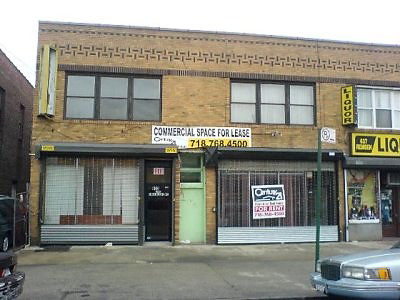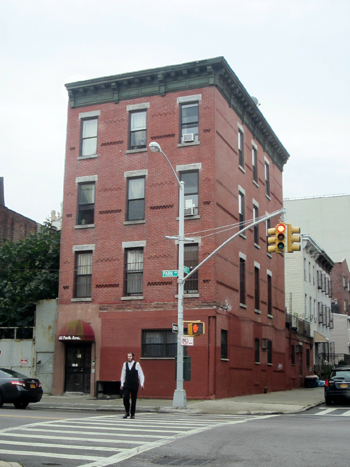Speak Out: Mixed-Use Properties
By Michele Gambetta
arttimesjournal December 10, 2017
If you are an artist and want to legally live and work in the same location, a mixed-use property might be for you!
 ArtCondo mixed-use artists' & businesses space. |
Mixed-use buildings are a unique and versatile type of commercial property, specially zoned to include both commercial and residential units. Mixed-use properties are residential-commercial hybrids where there is typically more residential square footage (space?) than commercial square footage (space?), and both are contained in a single building. These buildings are usually self-contained and small – typically 2-3 floors and with 2-5 units – giving owners a unique autonomy and freedom from other owners, and ability to collect rent from leased units. These properties are an often misunderstood real estate inventory and can be challenging to purchase, precisely because of their uniqueness and versatility. If you are considering owning a mixed-use building you need to understand more! ArtCondo Mixed-Use building for Artists
FEATURES
There are many varieties of mixed-use properties in New York City. The
boroughs of Brooklyn, Queens and the Bronx have many mixed-use brick
buildings with mom-n-pop storefronts on street-level containing bodegas or
delis, and 1-2 floors of residential units above. Less common are
single-family properties in small borough neighborhoods, with doctor’s or
dentist’s offices on the ground floor. Other variations include large
apartment building complexes with a full block of ground floor retail
containing needed neighborhood stores like dry-cleaners, deli, etc., and
residential apartments located behind or above.
Mixed-use properties are unique in that they provide owners with the ability to have two different legal occupancy uses - both residential and commercial tenants - in one building. In the vast majority of mixed-use properties, the residential portion takes up more square footage than the commercial portion, and yet these buildings are considered a subset of commercial real estate. These buildings are often purchased for their rent-roll income, and are considered an asset-class. Since they include both residential and commercial tenants they usually bring an attractive texture and synergy to neighborhoods.
THINGS TO KNOW BEFORE PURCHASING A MIXED USE PROPERTY
 ArtCondo Mixed-Use ArtCondo Mixed-Use |
Because of their unique features, mixed use properties require special consideration. They are a commercial product often purchased and owned by professional landlords to be rented to others, and transactions usually involve sophisticated sellers. (Residential units such as condominiums, co-ops, townhomes or single family homes are considered a “consumer” product since they are usually purchased by individuals to be owned and consumed/lived in, not rented out)
If you have found a mixed-use building you are interested in, thorough due diligence is critical. The risks (and resulting costs) could be significant if skimped on. You need to fully understand what you are purchasing and assuming liability for. New owners are responsible for things prior owners did incorrectly or didn’t do at all, so purchasers should have an experienced real estate attorney and real estate agent on their team to review all details. Many residential real estate agents are not familiar with mixed-use buildings since they are a small product niche often falling under provenance of commercial brokers, so be sure your real estate agent is familiar with this inventory or find a real estate agent who is.
DUE DILIGENCE
Due diligence issues include understanding the zoning and past use of the
building, the building rent-roll, and any outstanding Department of
Building, Certificate of Occupancy or zoning issues that will follow
possession of the deed. Past and present tenancy issues -- whether the
building is tenanted now or completely vacant – include the status of
leases, whether there were ever any illegal evictions or overcharging of
rent-stabilized tenants, and histories of current tenants. Some questions
include: How did this building become vacant? Were all construction and
renovations done correctly? Are there any open permits? Can current use be
grandfathered into the Certificate of Occupancy? How was commercial portion
of the building used in years prior? Is the building environmentally safe?
Because mixed-use buildings have two legally-zoned uses, owners must consider two or more different kinds of potential renters, types of leases, construction needs, liabilities and insurance -- unlike when buildings have only one legally-zoned usage. You should think these things through before purchasing.
ZONING ISSUES + CERTIFICATE OF OCCUPANCY
The building’s Certificate of Occupancy (CofO) must be reviewed by your
purchasing team. There have been cases where buyers failed to inspect the C
of O and did not realize until after the completed purchase that the
building was only commercial and not mixed-use, even though people were
living there. NYC buildings constructed before 1938 often do not have a
CofO, but the past use of the building can often be found and grandfathered
in. Everything is case-by-case, and needs to be reviewed by your attorney.
If a seller or broker tells you it is easy to change the use, speak to a
zoning attorney. Changing a building’s Certificate of Occupancy could take
8-12 months, if successful. You also want to know if the building has any
additional FAR (floor area ratio) “development rights” which could be added
to the building and increase its value.
TENANTS / REGULATIONS
When purchasing a mixed-use property, residential rent regulation and rent
stabilization laws need to be considered. NYC is a tenant friendly city –
especially for residential tenants – and you want to be sure you understand
the laws. People from other parts of USA or the globe often assume that the
residential tenants’ legal rights will be as limited as those of commercial
tenants, but that is not true in NYC. Some new owners of properties with
rent-regulated units have been blindsided by financial risks arising from
their (and their attorneys’) ignorance of those residential laws and
failure to take precautions to prevent loss. The careful negotiation of the
contract of sale and all the sellers terms and facts is essential to
preserve a building’s income and to proactively prevent future losses.
While commercial tenants are not as protected as residential tenants, they
can also bring their own issues and be hard to evict.
FINANCING
Financing a mixed-use property can be challenging for buyers who are not
professional landlords, but it is still usually possible for qualified
buyers, who can show 3 years of tax returns and bank statements. Mixed-Use
buildings are typically funded through commercial loans, but both Fannie
Mae and FHA allow mixed-use loans for financing both single-family and
two-to-four-unit mixed-use properties, as long as at least 51 percent of
the building is residential. The Small Business Administration (SBA) offers
a special loan with low down-payment options for small business owners --
which is a great option for artists, gallery owners and small creative
businesses that can show steady business income. The federal government
backs these SBA loans, resulting in a smaller needed down-payment and
highly competitive interest rates. Most banks will accept artists as “small
business owners” if their application is strong enough, and correctly
presented. A knowledgeable lender and real estate agent can help with this
positioning.
Mixed-use properties are appealing to owners because of the commercial income they can generate, but important to note that lenders are often uneasy if too high a percentage of a property's total income is generated by the commercial rather than the residential component. You will also have to pay the commercial tax rate and whatever associated business taxes your state requires.
INSURANCE
Insurance for mixed-use buildings is often not considered when purchasing,
but should be kept in mind. Will your commercial tenant be a child-care
organization, restaurant, laundromat, bank, deli? Each different business
has its own physical needs which determine whether the tenancy is possible,
as well as its own insurance needs. You want a good insurance agent to walk
you through commercial tenancy types and transfer of risk. Each commercial
tenant should be required to carry a liability policy of at least $1
million. Policies should name the landlord or building owner as an
additional insured. Building owners should not be held responsible for
tenants' customers. The insurance carrier for commercial tenants should be
rated B+ or better on the A.M. Best scale, which will indicate if the
insurance company has a good ability to meet its financial obligations.
Other insurance rating groups use different classifications, but the key is
to find a carrier with a “good” outlook.
 ArtCondo Mixed-Use building for Artists, Brooklyn |
Mixed-use buildings are a great inventory for artists and small businesses to consider, and can still be found in NYC for less than $1M in certain parts of the boroughs. Like all real estate in New York City, their value is greatly determined by their location, closeness to transportation, age, structure, amount of rent which can be commanded by the leased units (building's rent roll) and what the market will bear. These are fascinating property types often used by artists in 70s and 80s; and if you have never considered them seriously, I encourage you to check them out!
Next time you are walking through NYC, look up and around you to see if there are people living above or near the store you are visiting, and if you are standing in front of a mixed-use building…
ABOUT ARTCONDO + Michele Gambetta
ArtCondo LLC is a Brooklyn-based community-focused real estate initiative
created to help creative professionals purchase and develop buildings
throughout the NYC area in partnership with neighborhood residents. We are
working to help artists, arts non-profits and art-related businesses
purchase commercial and live/work spaces. Additional information is
available on our website www.ArtCondo.com.
Michele Gambetta is NYC-based artist who founded RIDER Projects, a mobile art gallery based in the social sculpture ideas of Joseph Bueys, exploring the potential of art to create positive social change. She is the recipient of a Presidential Scholarship and BFA from School of the Art Institute of Chicago, an MFA from School of Visual Arts, and attended University of Chicago and Bronx High School of Science. In 2005 & 2006 she was awarded Brooklyn Arts Council re-grants through the NYC Department of Cultural Affairs, and an Independence Community Foundation Grant in 2007.
Michele has been working in commercial and residential real estate for the last 15 years. She has a Certificate in Real Estate Finance and Investment from NYU Schack Institute, and has worked for a Manhattan real estate developer. She is a licensed NYS real estate salesperson with extensive professional relationships in NYC real estate and is a Certified Negotiation Expert.
Contact: Michele Gambetta, 646-245-9801 artcondo2013@gmail.com
